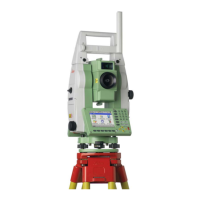Reference Line TPS1200+/TS30/TM30 91
8 Reference Line
8.1 Overview
Description The Reference Line application program can be used to set out or measure points
relative to a reference line or a reference arc.
Tasks The Reference Line application program can be used for the following tasks:
• Measuring to a line/arc where the position of a target point can be calculated
from its position relative to the defined reference line/arc.
• Staking to a line/arc where a target point is known and instructions to locate the
point are given relative to the reference line/arc.
• Gridstaking a line/arc where a grid can be staked relative to a reference line/arc.
• Staking to a polyline. Refer to "8.7 Staking to a Polyline".
Point types Heights and positions are always taken into account. Points must have full coordi-
nate triplets.
Terms
Defining a
reference line
A reference line can be defined in the following ways:
• Two known points
• One known point, an azimuth, a distance and a gradient
• One known point, an azimuth, a distance and a difference in height
• Polylines can be imported from a DXF job and selected from a list or on the Map
page. Refer to "8.7.1 Overview".
Defining a
reference arc
A reference arc can be defined in the following ways:
• Two known points and a radius
• Three known points
Defining chainage The chainage of the start point of a reference line/arc can be defined.
)
<Azimuth:> is used throughout this chapter. This can also mean <Bearing:>.
Reference point: The term "reference point" is used in this chapter to refer to the
point from which the perpendicular offset from the reference
line/arc, to the target point, is measured. Refer to paragraph
"Defining a reference line" and the diagrams for further explana-
tion.
Target point: The design point.
• For measuring to a reference line, this is the point with the
coordinates of the current position and the designed or
calculated height.
• For staking or grid staking to a reference line, this is the
point to be staked.
Measured point: The current position.

